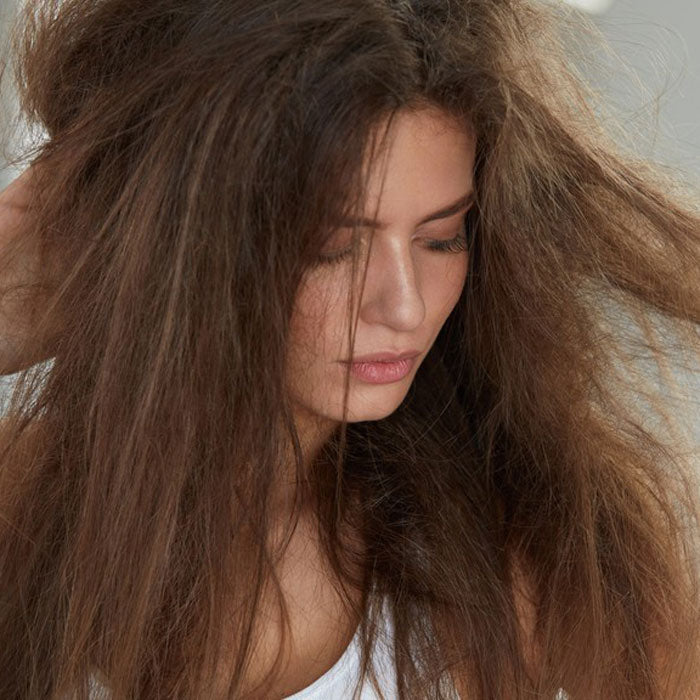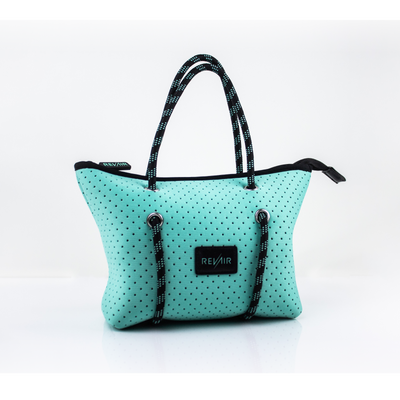
13 Ways to Repair Damaged Hair
Is your hair dry, frizzy, dull, and difficult to style? If so, it's probably damaged. Damaged hair is more common than you might think, and it can be really disheartening to deal with. It can leave you feeling hopeless — like you'll never have that soft, smooth hair you see on friends and in magazines. But rest assured, there are ways to repair damaged hair and prevent the same damage from occurring again. By taking better care of your hair and embracing habits to reverse damage, you can work your way towards the sleek, smooth locks you've always desired.
What Causes Damaged Hair?
The first step towards repairing your damaged hair is understanding what caused the damage so you don't keep making the same hair care mistakes. If you want to change your hair, you have to change your habits! There are four main culprits that account for most damage.
1. Dye, Bleach, and Other Harsh Chemical Treatments
In order to color your hair, dye solutions need to open up the cuticle — which is your hair's outer covering — and deposit color particles in the hair's cortex, which is the inside of the hair strand. If you dye your hair too often or with products that are too harsh on your cuticle, that cuticle won't lie flat again once you rinse the dye out. A rough, raised cuticle is a sure sign of damaged hair.
Bleach solutions can be even harsher on hair than standard dyes, since they are designed not only to open the cuticle, but to remove color from your hair's cortex. The more you bleach and lighten your hair, the dryer and more damaged it will become. This is why most stylists recommend against "going blonde" in one appointment and instead use a more gradual approach.
Similarly, perms and chemical straighteners can lift and damage the cuticle, leading to fuzziness and fly-aways. This damage is more likely if you apply the treatments yourself rather than working with a skilled stylist who can select the perfect formulas and treatment times based on your unique hair quality.
2. Sun Exposure
Ah, sunshine. It's fun to bask in the sun, but those UV rays can be as damaging to your hair as they are to your skin. They can raise your cuticle, leading to split and broken ends. If your hair seems to be more damaged and dry in the summer, sun exposure is likely at fault. Sitting in the sun may lighten the color of your locks, but it will also make them unruly. The damage will be even worse if you sit in the sun after taking a dip in a chlorinated pool.
3. Irresponsible Heat Styling
You're in a rush, so you turn your blow dryer on high to speed up the process. Then, you crank up your straightener and fry your hair to a crisp in an effort to get that straight, sleek look you desire. This is what's known as "irresponsible heat styling" or less formally, "frying your hair." Just a single session of high-heat straightening without the proper heat-protection spray can lead to a damaged cuticle and split ends. If you want to repair your damaged hair and prevent future damage, you're going to need to make big changes to your heat styling protocol — those changes are discussed in more detail below.
4. Poor Styling Techniques
Another common cause of damage is the little, day-to-day mistakes you make when styling your hair. This includes things like brushing your hair when it's wet. (You should only comb wet hair; brushes are too harsh and cause breakage). Pulling your hair into a tight ponytail every day can be damaging, too, as can using rubber bands and other "grippy" accessories. Many low-end styling products, like cheap hair sprays, are very alkaline and may contribute to damage by throwing off your hair's pH.
One little styling mistake won't lead to a whole head of frizz, but the damage adds up if you use these poor techniques every day.
How Can You Repair Damaged Hair?
Now that you hopefully have a better idea of what's caused your damaged locks, here are some ways to work towards repairing the damage. Expect a gradual improvement over the coming weeks and months as you integrate these new habits into your routine.
1. Visit the Salon for Regular Trims
When you have damaged hair, you should visit your stylist for a trim every 4 weeks. Your stylist will remove the damaged ends of your hair, preventing any splits from traveling further up your hair strands. If your hair is badly damaged, your stylist may recommend a shorter cut for the time being. Once the damaged ends of your hair have been removed, you can work on growing it back out again.
Even once your hair is in better shape, regular trims will prevent future damage. If you have fine or wavy hair, visit every 6 weeks. Those with fine or medium curls can wait 8 to 12 weeks between trims, and those with tight, coily hair can easily go 12 weeks once their damage has been repaired.
2. Switch to Hydrating Shampoo and Conditioner
When your hair is already dry and damaged, the last thing you need is a shampoo that strips away more of its oils. Look for hydrating shampoos and conditioners formulated specifically for damaged hair. These typically contain ingredients like vitamin E and essential fatty acids to help smooth your hair's cuticle and seal in moisture.
3. Rinse With Rice Water
Chinese women have long been rinsing their hair in rice water to keep it healthy and tangle-free as it grows. Rice water is really high in starch, which can help seal your damaged cuticle and prevent further moisture loss. Making your own rice water is pretty easy. Simply place ½ cup uncooked white rice in a bowl with 3 cups of warm water. Let the rice sit for 30 minutes, and then drain off the water.
To use your rice water, first shampoo and condition your hair as normal. Then, give it a final rinse with the rice water before drying it gently with a soft towel.
4. Rinse With Apple Cider Vinegar
If you have been using a lot of harsh styling products, like hair spray and hair gel, consider rinsing your hair with apple cider vinegar to help repair damage. The vinegar is acidic and will restore your hair to its natural pH, resulting in a smoother look and future damage prevention. Pour a cup of apple cider vinegar into a bucket of cool water, and then dip your hair into this rinse water after your normal shampooing and conditioning process.
5. Deep Condition Weekly
Once a week, after your normal shampooing routine, use a high-quality deep conditioner on your hair. Deep conditioners are better at penetrating and smoothing the cuticle than ordinary conditioners. They will instantly make your hair look smoother, and the essential fatty acids they leave behind will help prevent further damage from heat styling, UV rays, and harsh environmental conditions.
Look for a deep conditioner that is high in protein. The protein will help strengthen the hair and make it more elastic, so it is less prone to breakage. This is really helpful when your hair is already damaged and a bit fragile. Apply the deep conditioner according to instructions on the bottle; most formulas need to stay on your hair for 20 or 30 minutes. Deep conditioners formulated with shea butter work well for curly hair and coily hair. Formulas with coconut oil work well on wavy hair.
6. Use a Sun Protection Spray
If you're headed to the beach or preparing to spend the day outside gardening, apply a sun protection spray to your hair, first. These sprays are like sunscreen for your hair. They block UV rays to prevent your hair from becoming overly dry and damaged. If you don't have a sun protection spray on hand, wear a hat. Just make sure you pile all of your hair under the hat where it's safe and protected.
7. Avoid Chlorine
Spending time in the pool is fun, but the chlorine is really drying and can cause additional damage to your already frizzy hair. If you go swimming, pull your hair up and do not go under water — or wear a swim cap.
The water you shower in may also contain enough chlorine to damage your hair. The chlorine is added to sanitize the water, and while the amount that remains in the water should not be enough to make you sick, it is enough to dry out and damage your hair. Consider installing a filter in your shower; most filters are designed to remove chlorine. You should notice an improvement in your hair texture once you begin showering in dechlorinated, filtered water.
8. Wait Longer Between Shampoos
Even the best shampoos remove some of your hair's natural oils as they clean. Waiting longer between shampoos can help smooth and repair damaged hair. If you currently wash your hair every day, try switching to every other day. Then after a few weeks, start washing your hair every three days. If you feel like your hair starts to look greasy before you're due for your next shampoo, use a dry shampoo. Spray it along the roots of your hair; it will absorb oil without drying out your hair or causing additional damage.
9. Upgrade Your Heat Styling Tools
Are you still styling your hair with a high-heat blow dryer and a straightener that gets as hot as a campfire? If you want to repair your damaged hair, you need to make a change. RevAir is a new kind of hair dryer. It uses suction to keep your hair straight as it dries, which smooths the cuticle and helps prevent that frizzy, damaged appearance. Most users find that after using RevAir, their hair is so straight and smooth they don't even need to use a straightener. And if you do want to follow-up with a straightener, you'll just need to make a few quick strokes — so your hair won't be exposed to as much damaging heat.RevAir is also better for your hair because it operates at a lower temperature. You won't be frying your locks — just drying and smoothing them. In spite of the lower temperature, RevAir still works three times faster than conventional heat styling, so your hair receives less heat for less time, and therefore suffers less damage.
10. Use a Heat-Protection Spray & Leave-In Conditioner
Before you use any heat tools on your hair, make sure you apply a quality heat-protection spray. These sprays form an insulating layer around your hair, helping to seal the cuticle and protect it from damage. Ask your stylist to recommend a good heat protection spray for your hair type.
Leave-in conditioners are also extremely helpful in fighting frizz, reducing flyaways and providing some detangling and moisturizing benefits to your strands. Check out this comprehensive article on the best Leave-In Conditioners to add into your routine.
11. Avoid Chemical Relaxers
Until your hair is sleek and smooth again, you'll want to avoid chemical relaxing treatments. Ask your stylist to help you explore a new style that does not involve these harsh chemicals. Perhaps a new cut will allow you to fall in love with your natural hair, rather than feeling like you need perfectly straight hair. Or perhaps using a new styling tool, like RevAir, will allow you to achieve straight hair without the need for relaxing treatments.
12. Improve Your Diet
Good nutrition is essential for healthy hair. Focus on eating more fruits and veggies, as these foods are high in vitamins and minerals. Vitamin A will encourage healthy hair growth and moisture levels. Good sources include sweet potatoes, carrots, and kale. Vitamin C helps your body create collagen, a protein essential for strong, healthy hair. Good sources include citrus fruits, strawberries, and peppers.
13. Wear Your Hair Down
Constantly wearing your hair up and back is damaging, as it pulls and puts pressure on your hair follicles. Focus on finding a style you love so you're not tempted to pull your hair up as often. Experiment with new styling tools, like RevAir, that allow you to create beautiful looks in less time. Ask your salon professional for a cut that flatters your face shape and that does not require extensive styling to look nice.
If your hair is showing signs of damage, don't dismay. The damage may take a little time to repair, but with a few simple habit changes, you can enjoy sleek, smooth locks again soon. Contact us to learn more about how RevAir can help repair damage.















